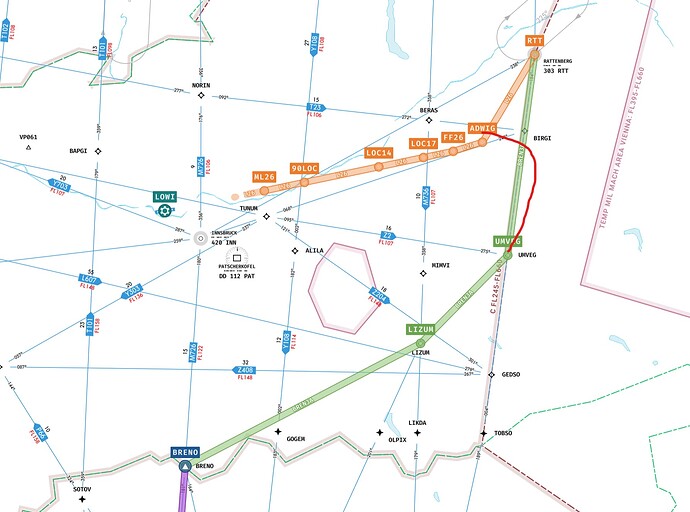Hello all,
I just did a flight from LFML to LOWI to RW26 with LOC26 approach and BREN3A arrival.
It included a transition via RTT, perhaps that is the issue, but I have planned my descent to be at 9500ft at RTT, but the aircraft (A32NX) did not even go there and like circle from UMVEG to ADWIG.
So I struggled then obviously, but still managed to land it.
Is this supposed to be like this or was the RTT transition anywas not a good idea?
I tried to draw a screenshot I flew then:
If this is the stock A320 in the sim, it may not be able to perform the proper reversal turn from the STAR to the IAF. The Inibuilds A320 will likely address that with a more AIRAC aware FMS.
Thanks, but it is the A32NX from FBW. Perhaps I ask there in the discord.
Hi,
I don’t claim to know how a real Airbus would cope, but I do fly into Innsbruck a lot in the Bae 146. Whenever I see a transition from a STAR to an approach that involves a nearly 180 degree turn it’s obviously going to be a problem for an airliner, especially if airspace is limited and you need an accurate transition to an instrument approach. There are a number of things you can do to help the aircraft.
- You can put the aircraft in heading mode, then briefly overfly the reporting point before commencing a turn onto the new heading, and then reengage LNAV.
- Reducing airspeed will help to make the turn as tight as possible.
- In this circumstance I would program a hold at RTT. The holding pattern is right hand approaching RTT on track 225 degrees. From the BREN2A arrival the aircraft would easily enter the hold and then on its first inbound track of 225 I would either cancel the hold as the aircraft approaches RTT, or put the aircraft on a heading of 207 from RTT to intercept the ILS. I think we have to accept that however wonderful these automated systems are, they don’t always do what we expect. The attached video is a great guide to the perils of automation dependency.
1 Like
Most FMCs are programmed to perform course reversals when the flight path shows a greater than 90 degree turn, taking into account aircraft performance. Course reversals usually mean overshooting the waypoint then following a large lateral loop. The pilot is expected to intervene as needed for speed control to meet efficient turn rates even if the aircraft is auto-throttle equipped.
@FiveCactus19675
Your 3) was the answer. Thanks!
Thanks, I love Innsbruck, especially the downwind visual approach to RW 08.

